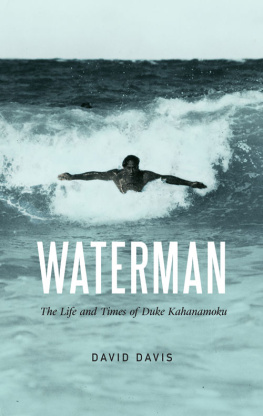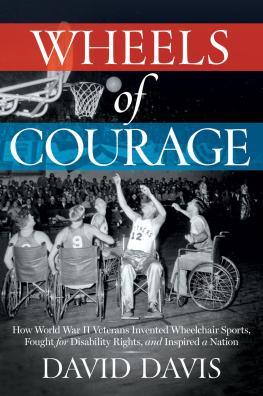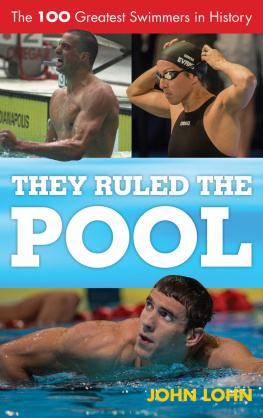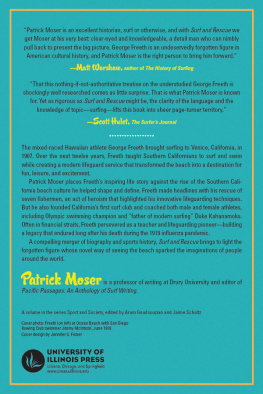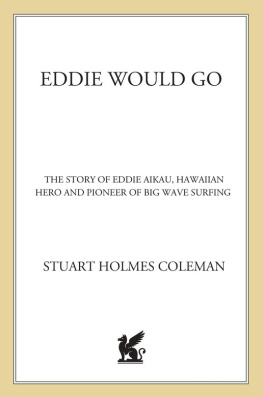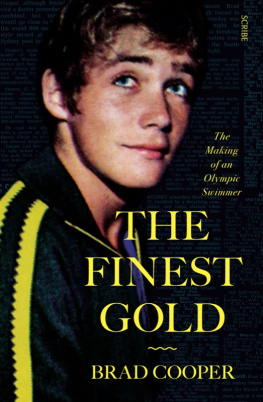David Davis has combined clear writing and meticulous research to present the life and times of one of the legends of Olympic history.
David Davis writes a wonderful tale of this royal ambassador of aloha effortlessly riding through a world of storms with magnanimity and grace.
Its remarkable how little we know about Duke Kahanamoku, one of the great figures in American sports history. As we discover in this book, there is much to be learned. We owe a debt of gratitude to David Davis for bringing the Dukes story so thoroughly to life.
Duke Kahanamoku unabashedly introduced his unique island mind-set and highly evolved ocean skills, all derived from the nature of his surroundings, to the world beyond Hawaii. For that, he is revered to this day.
Waterman
The Life and Times of Duke Kahanamoku
David Davis
University of Nebraska Press | Lincoln
2015 by David Davis
All rights reserved
Cover image is from the interior
Author photo courtesy of Robert Levins
Library of Congress Cataloging-in-Publication Data
Davis, David.
Waterman: the life and times of Duke Kahanamoku / David Davis.
pages cm
Includes bibliographical references and index.
ISBN 978-0-8032-5477-0 (cloth: alk. paper)
ISBN 978-0-8032-8512-5 (epub)
ISBN 978-0-8032-8513-2 (mobi)
ISBN 978-0-8032-8514-9 (pdf)
1. Kahanamoku, Duke, 18901968. 2. SwimmersHawaiiBiography. 3. SurfersHawaiiBiography. I. Title.
GV 838. K 35 D 38 2015
797.2'1092dc23
[B]
2015006562
The publisher does not have any control over and does not assume any responsibility for author or third-party websites or their content.
To my parents. Thank you.
Ua lehulehu a manomano ka ikena a ka Hawaii.
Great and numerous is the knowledge of the Hawaiians.
Hawaiian Proverb
Water is a kind of destiny.
Gaston Bachelard
Swimming cultivates imagination; the man with the most is he who can swim his solitary course night or day and forget a black earth full of people that push.
Annette Kellerman
To describe a wave analytically, to translate its every movement into words, one would have to invent a new vocabulary and perhaps also a new grammar and a new syntax, or else employ a system of notation like a musical score or algebraic formulas with derivatives and integers.
Italo Calvino
To write properly about the Olympic Games of the twentieth century is to write about almost everything in the twentieth century. About plastics and politics and racism and the demise of the rigid Bible morality and the rise of situation ethics. About avarice and airplanes and vitamin pills and chauvinism and free love and selling refrigerators on television and urban renewal and electricity.
William Oscar Johnson
The history of Hawaii is the history of loss.
Paradise lost?
Paradise stolen. Paradise raped. Paradise infected. Paradise owned, developed, packaged. Paradise sold.
David Lodge
I really dont know why it is that all of us are so committed to the sea, except I think it is because in addition to the fact that the sea changes and the light changes, and ships change, it is because we all came from the sea. And it is an interesting biological fact that all of us have, in our veins, the exact same percentage of salt in our blood that exists in the ocean, and, therefore, we have salt in our blood, in our sweat, in our tears. We are tied to the ocean. And when we go back to the sea, whether it is to sail or to watch it we are going back from whence we came.
John F. Kennedy
Contents
If you spend any amount of time on Oahu, the third largest of the Hawaiian Islands, you cannot help but notice the name Duke Kahanamoku everywhere. Theres Duke Kahanamoku Lagoon, Duke Kahanamoku Beach, and the Duke Kahanamoku Aquatic Complex. Theres the annual Duke Kahanamoku long-distance canoe race and the annual OceanFest carnival, which raises money for scholarships for the Duke Kahanamoku Foundation and is held near Dukes, the popular tiki-themed restaurant and bar with a superb view of the ocean.
Not far from the restaurant, on the beach at Waikiki, stands an oversized statue of Duke Kahanamoku. He is depicted wearing swimming trunks, with a surfboard behind him. His arms are extended as if to welcome the many visitorstourists in T-shirts and sunglasses, surfers with dreadlocks, military personnel in uniformwho have stopped to take photos and read the accompanying plaque.
As statues are wont to do, the bronze figure casts an enormous shadow over its surroundings, sort of like the man himself. While he was alive, Duke Kahanamoku was Hawaiis favorite son. Until Barack Obama came along, no one born in Hawaii was more famous or revered than Duke Kahanamoku.
Legend is a tricky thing. Director John Ford, a friend of Dukes from his stint in Hollywood in the 1920s, addressed this conundrum in one of the last (and best) Westerns that he directed. The plot of The Man Who Shot Liberty Valance revolves around an extended flashback concerning the fates of the two main characters in the movie (played by Jimmy Stewart and John Wayne).
A journalist asks Stewart, a successful elder statesman in the film, to discuss the long-ago incident during which he allegedly killed a scurrilous
Soon after his death in 1968 (or, perhaps, even before he passed away), the legend of Duke Kahanamoku supplanted the flesh-and-blood version. He officially competed in three Olympics, but reporters routinely stretched that number to four or five without supplying any concrete evidence. His famous Long Ride on a surfboard went from approximately one mile to one mile-and-a-half. He is said to have introduced surfing to Australia and the East Coast of the United States, even though others surfed there before him. Relatives of the worlds richest heiress, Doris Duke, claimed that Kahanamoku impregnated her, although that seems unlikely. Others have argued that he fulfilled a prophecy spoken by King Kamehameha, the unifier of the Hawaiian Islands, but it is doubtful that this prophecy was ever uttered.
As one of Kahanamokus relatives told me, with only some exaggeration, All that you now read bout the Duke is false, and for me to divulge the facts would place him in a shallow of the family worth. Let beliefs be if they help the progress of the entities of surfing and aloha, as they need a historical hero for commercialization.... Best to leave them to their wallows for it brings no harm and he is left the image of a hero.
Its easy to understand why Duke Kahanamoku continues to inspire such talk. His life was one epic ride. In 1890, when Kahanamoku was born, Hawaii was an independent nation. He was just a youngster when Hawaiis queen was overthrown in a hostile takeover that remains controversial to this day. He first gained fame while swimming for the United States at the 1912 Stockholm Olympics, at a time when nonwhite athletes were barred from competing at the elite professional and amateur levels (with the exception of a few boxers, jockeys, and collegiate stars).
A dark-skinned man who represented the hopes and dreams of a predominantly white nation, Kahanamoku encountered and traversed racism and ignorance well before the likes of other pioneers (including Joe Louis, Jesse Owens, and Jackie Robinson). As his swimming success continued into the 1920s, he integrated private and public pools as well as surfing spots at exclusively white beaches. Photographs of Duke holding white women in his arms while they swam, or bearing them aloft on his powerful shoulders while they surfed tandem, appeared in newspapers around the country. He became the living embodiment of Hawaii and its exotic cultureand what a symbol! He was seen as the distillation of everything that was believed to be good about the Hawaiian people: humble yet powerful, sensual and healthy, gracious and noble.

